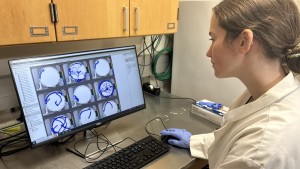A mouse scurries across a platform, trying to evade a bright light from above. A series of 40 holes line the perimeter, and only one of them offers an exit.
The mouse investigates, nosing the holes: nothing there, nothing here, still nothing.
With time and a bit of luck, the mouse eventually finds the target, a small, enclosed box. It hops in, rewarded with comforting darkness.
The mouse has just completed its first run of the “Barnes maze,” an apparatus designed to evaluate spatial and learning memory in mice, and a tool that is crucial to one student’s work on campus this summer.
Through the Summer Science Scholars program, neuroscience major Kiersten Hoffmann ’25 is conducting research under Professor of Neuroscience Hewlet McFarlane, examining spatial and learning memory in autism spectrum disorder model mice. The mice in question are an inbred strain of mice formally known as BTBR T+tf/J (BTBR).
While the mice aren’t actually autistic, they do exhibit behaviors similar to those observed in humans with autism: impeded social communication and interaction, and repetitive behaviors. For the mice, this means less sociability toward strangers, less social sniffing, fewer social interactions, repetitive grooming, and less play.
What drives this experiment? “Children with autism spectrum disorder perform lower on cognitive spatial working memory tests compared to typically developing children,” Hoffmann stated. “There’s a dysfunction with NMDA receptors (important components of memory) in children with autism.”
If Hoffmann’s experiment reveals that BTBR mice also perform lower than their peers, this model could be used to explore ways to mitigate this issue. McFarlane’s previous research has investigated how inhibiting growth hormones in regular mice can change the composition of their NMDA receptors. It turns out that slowing the mice’s growth increases the amount of a particular NMDA subunit associated with early development and adaptability, thereby improving their spatial and learning memory. Next steps could involve testing whether growth hormone inhibition in the BTBR mice leads to similar improvements.
In the lab at Samuel Mather Hall, Hoffmann uses the Barnes maze to test both the short-term and long-term spatial and learning memory of the mice. They undergo training trials in the coming days, trying the maze over and over again. All the while, Hoffmann records their search strategies using a system of cameras and software that create heat maps for every individual trial and mouse.
On testing day, the exit box is completely removed to avoid possible cues related to sight or smell. If the mouse’s memory and learning holds, it will go to the hole that once led to the box to try to hide from the light. Its performance is measured by the overall time it takes to get to the target hole, misadventures into wrong holes, and the path of its search.
As a student aspiring to pursue research in graduate school, this opportunity has empowered Hoffmann: “It made me super independent — more trusting of myself and more ‘I can do this.’”
This article was written by Michelle Polak ’25 as part of the Hoskins Frame Summer Science Writing Scholars program.
